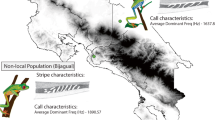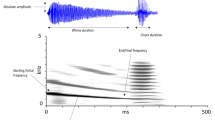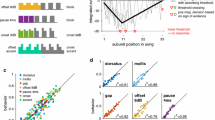Abstract
The evolutionary significance of female choice is controversial1. Central to the issue are the mechanisms and criteria used by females to choose among potential sexual partners. For example, females merely responding to conspicuous displays that are uncorrelated with male condition or quality would neither incur costs of assessment nor gain benefits over and above random mating2. Here we show that selective phonotaxis by female gray tree frogs depends on non-arbitrary acoustic cues that indicate the male's species and energetic costs of signal production. Furthermore, some female preferences cannot be explained by differences in signal conspicuousness (acoustic energy) alone. Females obviously benefit by rejecting genetically incompatible, heterospecific males, which can be identified solely by pulse rate. Females also select among conspecific males on the basis of call duration, which is correlated with a male's energetic investment in courtship and probably indicates his physical condition and fitness.
Similar content being viewed by others
References
Partridge, L. & Halliday, T. in Behavioural Ecology: An Evolutionary Approach 2nd edn (eds Krebs, J. R. & Davies, N. B.) 222–250 (Blackwell, Oxford, 1984).
Parker, G. A. in Mate Choice (ed. Bateson, P.) 141–164 (Cambridge University Press, Cambridge, 1983).
Halliday, T. R. in Behavioural Ecology: An Evolutionary Approach (eds Krebs, J. R. & Davies, N. B.) 180–213 (Sinauer, Sunderland, Massachusetts, 1978).
Fellers, G. M. Anim. Behav. 27, 107–119 (1979).
Arak, A. Nature 306, 261–262 (1983).
Taigen, T. L. & Wells, K. D. J. comp. Physiol. B 155, 163–170 (1984).
Wells, K. D. & Taigen, T. L. Behav. Ecol. Sociobiol. 19, 9–18 (1986).
Burger, J. C. thesis, Univ. Missouri (1980).
Gerhardt, H. C. Science 199, 992–994 (1978).
Fisher, R. A. The Genetical Theory of Natural Selection (Dover, New York, 1958).
Andersson, M. Nature 299, 818–820 (1982).
Majerus, M. E. N., O'Donald, P. & Weir, J. Nature 300, 521–523 (1982).
Andersson, M. Biol. J. Linn. Soc. 17, 375–393 (1982).
Lambrechts, M. & Dohndt, A. A. Behav. Ecol. Sociobiol. 19, 57–63 (1986).
Majerus, M. E. N. Trends Ecol. Evol. 1, 1–7 (1986).
Gerhardt, H. C. Behaviour 49, 130–151 (1974).
Author information
Authors and Affiliations
Rights and permissions
About this article
Cite this article
Klump, G., Gerhardt, H. Use of non-arbitrary acoustic criteria in mate choice by female gray tree frogs. Nature 326, 286–288 (1987). https://doi.org/10.1038/326286a0
Received:
Accepted:
Issue Date:
DOI: https://doi.org/10.1038/326286a0
- Springer Nature Limited
This article is cited by
-
Endurance rivalry and female choice jointly influence male mating success in the emerald treefrog (Zhangixalus prasinatus), a lek-chorusing anuran
BMC Zoology (2022)
-
Social modulation of spatial dynamics in treefrog choruses
Behavioral Ecology and Sociobiology (2022)
-
Multiple phenotypic traits predict male mating success in a critically endangered frog
Behavioral Ecology and Sociobiology (2022)
-
Arginine vasotocin affects motivation to call, but not calling plasticity, in Cope’s gray treefrog Hyla chrysoscelis
Journal of Comparative Physiology B (2022)
-
Auditory and distance cues interact to modulate female gray treefrog preferences for male advertisement calls
Behavioral Ecology and Sociobiology (2021)





